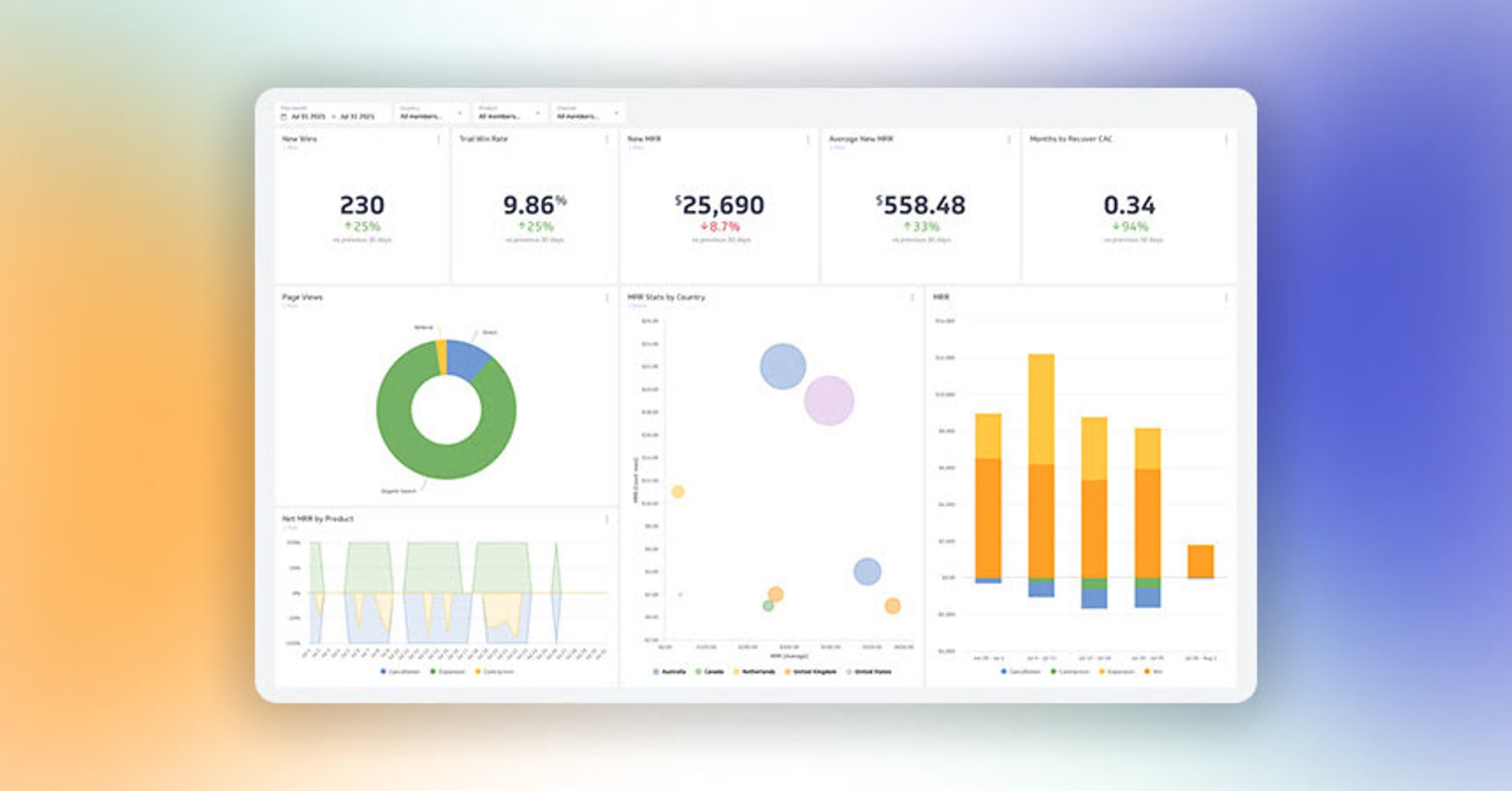Supercharge your KPIs with OKRs

Published 2023-09-27
Summary - If you’ve read this blog at all over the past few years, you’ll know that we are smitten with key performance indicators.
If you’ve read this blog at all over the past few years, you’ll know that we are smitten with key performance indicators (KPIs).
And why not? KPIs are important! They allow a business to monitor its underlying performance, build a better team and focus employees’ strategic efforts.
But just because we love KPIs doesn’t mean we can’t branch out every now and then.
There are a slew of performance management tools out there, all of which taken together have enough acronyms to make a bowl of alphabet soup jealous.
One in particular, though, is worthy of our attention: Objectives and key results. OKRs, as they are known, are a great tool for identifying new initiatives and setting ambitious targets.
The best part? We don’t even need to abandon our first love. OKRs, it turns out, are ideal for supplementing your KPIs.
So before you damn our wandering eyes, hear us out! You might just find the perfect tool for reigniting your love affair with KPIs.
So what are OKRs anyways?
OKRs are a performance management tool that sets, communicates and monitors goals in an organization. The idea is to set expectations that get all employees at your company working together in one unified direction.
OKRs were used at Intel in the 1970s, when the company was transitioning from a memory company to a microprocessor company. However they really took off after John Doerr, a former Intel employee, introduced them at Google (the company with which they are now synonymous). Today OKRs are used predominantly in the technology sector as a means of setting and measuring quarterly goals. Increasingly, though, they are expanding into more and more of the business world.
OKRs consist of two main components:
- Objectives: What you want to achieve. These typically involve setting a goal (usually qualitative in nature) around a specific initiative you hope to improve or work on.
- Key results: How you will achieve your objective. These are quantitative goals that are measurable and have a defined time limit by which they need to be accomplished.
An OKR typically includes one objective, each of which has four to five key results (or fewer). At any one time a company will have several objectives, each of will have their own individual key results.
Consider this example. Let’s say that you’re the lowly Cleveland Browns, who just became the second-ever NFL team in history to go 0-16.
The Browns have a lot of problems, but one area where they’ll absolutely have to improve if they ever want to win a game again is in reducing the number of interceptions they throw.
In that case they might set the following OKR.
Objective: Improve passing game, with a particular emphasis on reducing interceptions
Key results:
- Draft a quarterback with an interception ratio (the number of interceptions divided by passes thrown) that’s under 1.0 per cent
- Reduce the number of bobbled passes from receivers to under five per cent
- Achieve a run-to-pass ratio of 45:55
Here’s an example that’s closer to the business world. Let’s say you’re a traditional retailer that’s just launched its first online store but are disappointed with the early returns. Here’s what your OKR might look like.
Objective: Create a best-in-class ecommerce marketing campaign
Key results:
- Run five social media advertising campaigns
- Boost website visitors by 300 per cent
- Set up three remarketing pixels/tags
- Secure one influencer endorsement
OKRs sound pretty similar to KPIs – what’s the difference?
In some ways, KPIs and OKRs are the same. For example: The “objective” part of OKRs isn’t that dissimilar from individual KPIs (though that of course depends on whether you’re setting a qualitative or quantitative objective).
But there are also key differences.
Let’s revisit, for a second, our definition of KPIs:
A Key Performance Indicator (KPI) is a measurable value that demonstrates how effectively a company is achieving key business objectives.
A few things are worth noting here. The first is the focus KPIs have on “key business objectives.” This means that KPIs focus on not just any initiative. They need to be essential to the performance of your department or entire business. The second is the focus on achievement. The idea is to set a goal that tells you how healthy your business is. They tell you what really matters if your business is to be successful overall, not just in a particular area you want to focus on.
OKRs, by contrast, aren’t necessarily about underlying strategic goals (though they can be). Instead OKRs are usually directed towards specific initiatives.
OKRs are also different in that they are measured on a scale of 0 to 1.0. KPIs, by contrast, are measured using whatever metric you’ve adopted – revenue, say, or sales.
One final difference worth noting is particularly important: KPIs are, with some exceptions, meant to be achievable. KPIs are typically SMART – meaning they are Specific, Measurable, Attainable, Relevant, and have a Time Frame for achievement (emphasis here on the “A” part of SMART).
OKRs, by contrast, aren’t.
“The “sweet spot” for an OKR grade is 60% – 70%,” says Google. “If someone consistently fully attains their objectives, their OKRs aren’t ambitious enough and they need to think bigger.”
Google even goes so far as to say that managers who consistently exceed their key result targets are likely hoarding resources.
Sorry, I’m still a little confused
Here – use this handy chart!
| KPIs | OKRs | |
|---|---|---|
| Difficulty | Achievable, based around the SMART framework | Challenging, purposely ambitious/unachievable |
| Metric | Unique to each KPI | Graded on a scale of 0 to 1.0 |
| Ideal achievement level | Meet or exceed expectations | Ideal grade is between 60 and 70 per cent (anything more suggests expectations weren’t high enough) |
| Primary role | Monitor underlying business/department success | Address shortcomings and implement change |
| Update frequency | Evolve frequently | Change frequently |
OK I think I get it now. But I’m still not clear on why I would ever want to use OKRs
OKRs are useful for a few different reasons.
To push your team out of its comfort zone
OKRs are designed to be unattainable for a reason. In fact, this is what Google says sets OKRs apart from other goal-setting techniques.
“OKRs can enable teams to focus on the big bets and accomplish more than the team thought was possible, even if they don’t fully attain the stated goal,” says Google.
“OKRs can help teams and individuals get outside of their comfort zones, prioritize work, and learn from both success and failure.”
As a communication and team-building tool
OKRs are an excellent tool for telling your team what your expectations are for them. They set out, in exact terms, what your priorities are for the team and what you expect them to achieve.
They’re also an excellent tool for lessening the temptation towards micromanagement and eradicating redundant collaboration techniques.
“OKRs allow us to eliminate cascading level after level after level, which requires meeting after meeting after meeting,” said Laszlo Bock, Google’s former SVP of People Operations. “You publish the key big priorities and initiatives that need to get done, and let people fill in the details of how they're going to get it done.”
To address a shortcoming that needs to be addressed
OKRs are ideal for identifying areas where your company wants to improve. Unlike KPIs, which are used to assess the underlying health of your business, setting OKRs are ideal for addressing problematic areas.
To identify and measure change in your organization
Because KPIs are more focused on overall strategy, they are less ideal for setting goals for major changes you hope to address. Adopting a new KPI or changing an existing one has an inherent element of change. But it doesn’t set out, in the same way as an OKR, what specifically you hope to do differently.
But I thought you said OKRs worked well with KPIs?
They do! KPIs and OKRs, used properly, can serve different but equally important purposes.
Consider it this way: KPIs are important for strategy. They allow you to decide on and communicate what your strategic goals are for the organization. A KPI says to everyone “OK, if this business is going to be successful, THIS is what we’re going to need to achieve.”
OKRs, by contrast, can serve a tactical purpose. They allow you to identify particular initiatives that you want your team to work on and then have them get to work.
Let’s pick up on one example from earlier. In this case you’re a traditional store that’s seeing a decline sales. You know you need to modernize, so you decide to launch an online store. In this case you would set a KPI for sales from your new online store (since your traditional sales are declining, you’ll need to boost your revenue on other platforms in order to survive, much less thrive).
So you’ve got your KPI, but that’s just part of the picture. You also need to decide on and implement, at the tactical level, initiatives that will allow you to make good on your strategy. What changes can you implement that will help you achieve progress?
Here’s where OKRs come in.
You know you need to challenge yourself to achieve your key goal. If you didn’t, you wouldn’t need to move into a new market. By setting some OKRs, you can help address the shortcomings in your underperforming ecommerce strategy.
You dive into your metrics and find that your store is underperforming because you’re not getting a lot of traffic.
People simply don’t know your store exists. So you decide that you need to improve your digital marketing game to increase awareness.
You’ve got your objective: Boost your online store’s digital marketing strategy. But to achieve that goal you’ll need to implement some major tactical changes. Perhaps something along the lines of the following:
- Generate 100,000 clickthroughs from organic social media posts
- Generate two million views through targeted ads on social media, Google AdWords and Criteo
- Run five different annual campaigns aimed at boosting ecommerce sales across owned media
- Recruit three social media or YouTube influencers to advertise your brand
When is a good time to use OKRs?
OKRs can also be deployed at different times, depending on the situation your company is in at a given moment.
Think of it this way: There should never not be a time when you’re not using KPIs to measure the health of your business.
However there are times when OKRs will be particularly useful. Here are a few occasions where an OKR might be an ideal tool to use:
Your company is undergoing a strategic shift
Your KPIs should always keep pace with your business’s underlying strategic goals. If you’re launching a brand new product line, embarking on a major acquisition spree or branching out into new business areas, you’ll want to make sure you change and update your KPIs to reflect these shifts.
But you’ll also need to get specific about how you’re going to achieve them. At a more tactical level, what are the objectives and key results that will allow you to follow through on underlying strategic changes?
Your company’s performance isn’t meeting expectations
Let’s say that one of your KPIs is a 90 percent customer satisfaction rating. For the most part you’ve managed to hit your target. But one quarter you find your rating dipping well below expectations.
This would be a great time to set an OKR or two to address the situation. The first objective would likely be to find out why your customer satisfaction rating is falling, with a potential key result being a completed audit of the customer experience. The second objective? To address the situation. Here a key result might be to introduce a new customer satisfaction program or to retrain employees who deal with customers on a regular basis.
With these OKRs, you now have a concrete plan for dealing with your company’s sub-par performance regarding your KPI.
Your employees are complacent
People – particularly high-performers – need to be challenged. Sometimes employees underperform because they’re burnt out. Just as frequently, though, performance slips because they have become complacent and don’t feel excited about what they’re asked to do on a daily basis.
OKRs, because they are purposely designed to be unattainable, help to challenge your employees and push them out of their comfort zone.
Some people won’t like the prospect of chasing a goal that is purposely designed to not be achieved, but it’s possible they might not be the type of performer you want on the team anyways.
Bringing it all together
Have you tried augmenting your KPIs with OKRs? Let us know what’s worked – and what hasn’t – in the comments below!
Related Articles

17 KPIs Every Data-Driven Manager Needs to Lead Their Team
By Danielle Poleski — October 14th, 2025
7 ways to present KPIs that your management team will love
By Danielle Poleski — September 25th, 2025
12 Important Sales Enablement Metrics You Shouldn't Miss
By Grace Lau — September 19th, 2025

